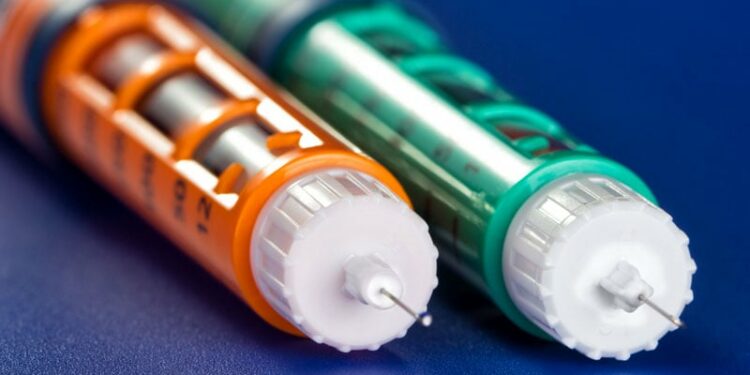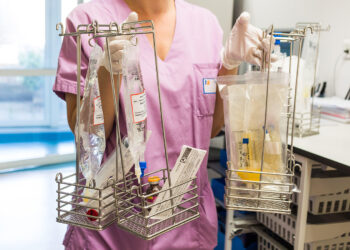[ad_1]
As glucagon-like peptide 1 (GLP-1) receptor agonist use becomes more prevalent, patients are using them for new indications — and at new dosages.
Say hello to microdosing, or taking doses lower than the recommended therapeutic amount, for various reasons: Weight maintenance, metabolic health improvements, anti-inflammation and anti-autoimmune effects, fewer side effects, and lower costs.
Advocates say microdosing reduces costs and side effects while maintaining weight loss, then can help with weight maintenance. The approach is especially popular among telemedicine physicians, who typically offer more affordably priced compounded versions of the medications, at about ≤ $200 a month.
Considering that in 2024, only 34% of employee health insurance plans surveyed covered the GLP-1 medications for both weight loss and diabetes, and without insurance, the brand-name medicines can cost $1000-$1300 monthly.
Patients have responded in a big way. On social media platforms, patients tout the appeal of microdosing, trading stories and suggestions for how much to microdose. One reddit thread on GLP-1 microdosing, with 1.7 thousand members, aims to explore the benefits of the medications beyond obesity and diabetes, such as less inflammation and more concentration. At least two Facebook groups devoted to microdosing the medications have formed.
However, critics of the approach worry about the lack of published research, the potential for contamination, the dangers of patients deciding their own dose, and what they see as the uncertain future for compounded GLP-1s.
“This practice lacks clinical guideline support and introduces risks, particularly with compounded formulations that lack FDA [US Food and Drug Administration] approval and cannot guarantee consistent quality or efficacy,” said Priya Jaisinghani, MD, an endocrinologist and obesity medicine specialist with NYU Langone Health in New York City.
Microdosing GLP-1s: ‘Low and Slow’
Craig Koniver, MD, a family medicine physician in Charleston, South Carolina, said he has all 200 of his patients who are taking the GlP-1s for weight loss on microdoses. And how is he defining it? “Technically that’s 10% of a macro dose,” he said, but doses for every patient are individualized. For instance, the Zepbound (tirzepatide) maximum pen dose is 15 mg, the lowest 2.5 mg. Koniver said he usually starts women on 1.5 mg of tirzepatide, men on about 1.8 mg or 2 mg.
He stresses a low and slow approach, he said. “Our goal is 2 pounds of weight loss a week or less.” Some patients stay on the lower dose and lose, others move on to higher doses, he said. He tailors the amount to the patient, with some finding they do okay on twice monthly injections, or even fewer. “There’s lots of variation,” he said. “A lot will go back to the microdose as maintenance.”
Along with the medications, Koniver advises patients to cut portions and make other lifestyle changes. “We can do telemedicine, as we have a physician licensed in all 50 states. But every patient we see comes in person at some point.”
As the use of GLP-1 drugs increases, clinicians are thinking differently about how to manage patients with diabetes, obesity, and other comorbid conditions.
“The past 2 years have been transformative, with research demonstrating the effectiveness of GLP-1s not just for obesity, but as part of a broader approach to cardiometabolic health,” said Rekha Kumar, MD, an endocrinologist and obesity medicine specialist at Weill Cornell Medicine, New York City.
In her practice, Kumar has seen how early intervention with GLP-1 drugs can help prevent a cascade of health challenges often associated with metabolic conditions. The early intervention approach, she said, shifts metabolic healthcare from reactive treatment to proactive prevention.
GLP-1 microdosing, in particular, offers a slow and steady way for patients to improve their metabolic health before more serious conditions develop, while minimizing the risk of side effects.
“The conversation around microdosing GLP-1s reflects a growing recognition that metabolic care isn’t one-size-fits-all,” she said. “We’re seeing a shift toward earlier intervention, more tailored treatment plans, and greater emphasis on affordable access.”
Even as real-world experiences indicate that microdosing or off-label use of GLP-1 drugs can offer benefits, physicians recommend caution around the dosage, timing, and mechanisms of action for now.
“It’s the Wild West out there, and I’m interested to see how the data turns out. At this point, I neither recommend nor discourage microdosing,” said Michael Snyder, MD, medical director of the Bariatric Surgery Center at Rose Medical Center in Denver, Colorado.
In coming years, long-term studies may show the benefits that GLP-1 and other peptide-based drugs hold for organs affected by obesity, including the liver, pancreas, and kidneys, he said.
“We know that people are veering off the FDA-approved script all the time with these drugs, and sometimes with noticeable results,” Snyder said. “To me, the biggest benefit so far is bringing this discussion into the public eye, where we’re demystifying obesity and dropping the blame and shame around addressing metabolic issues.”
Until more scientific data emerge on microdosing or a low-dose regimen, though, many physicians plan to stick with the recommended doses studied in clinical trials.
Priya Jaisinghani, MD
This practice lacks clinical guideline support and introduces risks, particularly with compounded formulations that lack FDA approval and cannot guarantee consistent quality or efficacy.
“We do not do microdosing,” said Caroline Apovian, MD, DABOM, Harvard Medical School, Boston, and professor of medicine and co-director of the Center for Weight Management and Wellness at Brigham and Women’s Hospital, Boston. “I am against any of this,” she said, citing dangers if pens or vials are used against instructions.
“The microdosing trend seems to be most common in people without clinical obesity,” said Sarah Stombaugh, MD, an obesity medicine and family medicine physician in Charlottesville, Virginia. “Patients with clinical obesity are unlikely to have significant benefit from taking very small doses of GlP-1 medication.”
Critics worry about contamination when a smaller dose is used, and the rest is left for later. It’s a legitimate concern, Stombaugh said. While it’s difficult to inject a partial dose from the single dose GLP-1 brand name pens approved for weight loss, a partial dose can be withdrawn, then injected, from a single-dose vial. She has also heard of people injecting brand name GLP-1 weight loss medications from a pen into a vial, then drawing out a partial dose. “This is both technically difficult and has a significant risk of contamination,” she said.
Future of Compounding GLP-1s?
Compounders may prepare compounded versions of a drug if it appears on the agency’s shortage list. The brand-name GLP-1 medications go on and off the FDA drug shortage list frequently, further upping the appeal of the compounded versions. As of January 26, the tirzepatide shortage is resolved, according to the FDA, but semaglutide remains in shortage. As the supplies stabilize, the FDA said in December that it will not take action against tirzepatide compounders until March 19, 2025.
Another potential roadblock for compounded GLP-1s are the requests by Lilly and Novo Nordisk, to put Zepbound and Wegovy on its “Demonstrably Difficult to Compound” list.
Not surprisingly, both Lilly and Novo Nordisk spokespersons discouraged microdosing. In a statement, a spokesperson for Novo Nordisk said: “We do not condone the misuse of our products.” Only the marked doses on the single-use, fixed-dose pens, at 0.25 mg, 0.5 mg, 1.0 mg, 1.7 mg, and 2.4 mg are approved and represent an authentic FDA-approved medicine, it said.
In a statement, a Lilly spokesperson said: “Lilly does not promote or encourage use of Mounjaro, Zepbound, or any Lilly medicines outside of the medicine’s FDA-approved label.” Zepbound’s starting dose is 2.5 mg, with maintenance doses at 5 mg, 10mg, or 15 mg.
[ad_2]
Source link : https://www.medscape.com/viewarticle/some-patients-and-doctors-turn-microdosing-glp-1s-2025a10002y1?src=rss
Author :
Publish date : 2025-02-06 07:15:41
Copyright for syndicated content belongs to the linked Source.














